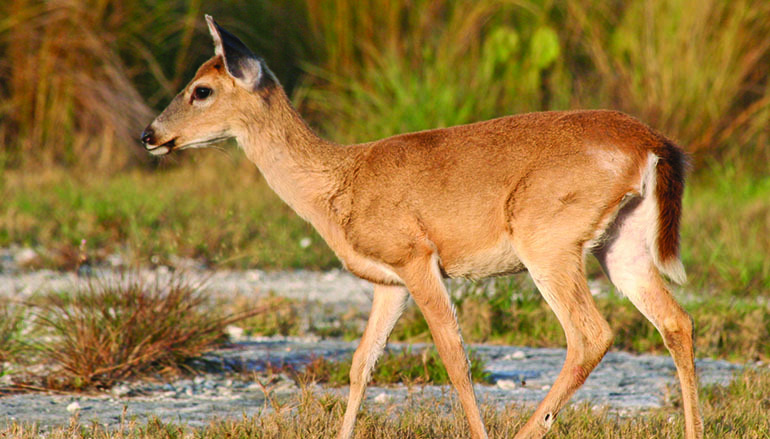
Texas A&M Researchers Helping Key Deer
Key deer plagued by screwworm outbreak
SAN ANTONIO – For the past several months, a Texas A&M University System institute has been actively involved in efforts to quash a screwworm outbreak in Florida jeopardizing an already endangered species, Florida’s Key deer.
“While there had been no screwworm outbreaks in the U.S. for the past 30 years, one began last July on Big Pine Key, which affected the Key deer population,” said Dr. Roel Lopez, Institute of Renewable Natural Resources director and co-principal investigator for the Key deer study.
Key deer are a diminutive subspecies of white-tailed deer found only in the Lower Florida Keys. Over the following months, screwworms infested the population, which is spread across more than 20 islands. It has led to 135 Key deer deaths, including 83 euthanized to reduce risk of further infection. “This was a significant blow to a species of which is uniquely located in that area and has an estimated population of just 875,” Lopez said.
Screwworm infestation killed mostly male Key deer
“With the U.S. Fish and Wildlife Service as the lead agency, we have been researching screwworm impacts and spatial distribution, as well as deer population density based on sex ratio and age,” Lopez said. “We have also been involved in determining management implications for protecting the deer.
… efforts have been focused on helping determine how this endangered species will fare following the infestation.”
“All but 10 of the Key deer deaths from screwworm infestation were males,” said Dr. Nova Silvy, Regents Professor in Texas A&M’s wildlife and fisheries sciences department. “In these males, screwworms typically infected open wounds created by their fighting during their rutting season, which is from September to December, as they competed for females.” He explained screwworm fly larvae feed on warm-blooded animal tissue, so the open wounds from the deer rut provided an environment for screwworms to infest and lay eggs. “The screwworms eat the flesh around the wound until the deer becomes incapacitated or dies,” he said.
Screwworms could cause problems for nearby animals
According to Dr. Israel Parker, a research scientist and another co-principal investigator for the study, the screwworm infestation could also cause problems for other warm-blooded animals in the area. For his master’s degree work at Texas A&M, Parker was involved in the translocation of Key deer during a 2005 survey.
“Screwworms can have devastating effects on livestock populations, so an outbreak could potentially affect many agricultural operations, depending on how widely it spreads,” he said. “The last major infestation of the screwworm in the 1960s was a significant concern for livestock producers in Texas, so it’s very important screwworms be addressed in the Florida Keys before they possibly spread and affect livestock operations on the mainland.”
Silvy noted while so far interagency efforts have been highly successful in halting the outbreak, further screwworm infestations may appear in the spring as Key does start giving birth.
“The flies could infest the afterbirth or the navels of the fawns, a common problem with calves in areas with screwworms,” he said.
Researchers using radio collars, conducting population estimates
To help control the outbreak and assess the survivability of the Key deer, Lopez, Silvy, Parker and others from the institute have traveled to Florida to conduct deer population estimates and projections. They have also placed radio collars on 30 Key deer does to help find if they may be vulnerable to screwworm flies while giving birth.
“Working together, our agencies have been able to stave off further screwworm infestations,” Lopez said. “Additionally, the institute’s male-to-female population ratio estimate showed a high probability the Key deer population will continue to be viable because the adult males that died can be replaced by younger males that can mate with multiple does.
“Estimates indicate there appear to be enough males to complete the breeding season. They also show a long-term population increase of about 3.5 percent annually, which should continue.”
Lopez said preventive treatment and screwworm fly eradication efforts by other cooperating agencies have been highly successful. These have included setting up feeder stations rimmed with anti-parasitic medications and releasing 60 million sterile male screwworms to mate with wild female flies, stifling their reproductive capacity. “In addition, several deer enclosures are proposed to be built at the National Key Deer Refuge to trap and care for healthy specimens if herd numbers become uncomfortably low,” he said.
Lopez said he hopes these strategies, in addition to continuing the monitoring protocol, conducting intensive monthly surveys, possible translocation and long-term monitoring of outer Key islands impacted by screwworm, will help ensure the survival of the Key deer.
Joseph C. Boone photo



